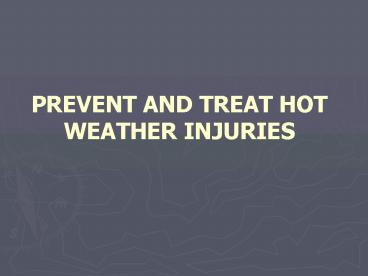PREVENT AND TREAT HOT WEATHER INJURIES - PowerPoint PPT Presentation
1 / 19
Title:
PREVENT AND TREAT HOT WEATHER INJURIES
Description:
can occur at any time during the year, but are most common during the summer ... Avoid sunburn. Watch other members of the team for beginning signs of heat stress. ... – PowerPoint PPT presentation
Number of Views:180
Avg rating:3.0/5.0
Title: PREVENT AND TREAT HOT WEATHER INJURIES
1
PREVENT AND TREAT HOT WEATHER INJURIES
2
OBJECTIVES
- Prevent hot weather injuries and recognize and
treat those that do occur.
3
Heat injuries (sometimes called heat stress) are
the result of overexertion and dehydration. These
conditionscan occur at any time during the year,
but are most common during the summer months with
high temperaturesand humidity.
4
To prevent heat stress
- Ensure you are drinking enough water per day.
Sipping is better than - trying to drink an entire quart at a time.
5
Monitor the color of your urine. It should be
almost clear in color. If it is brown or dark
yellow, youare becoming dehydrated.
6
Wear loose fitting and open clothing.Do not
overexert yourself.Avoid sunburn
7
Watch other members of the team for beginning
signs of heat stress.
- Immediately stop, rest and drink some water.
- Use the buddy system
8
There are three major types of heat injuries
- heat cramps,
- heat exhaustion,
- heat stroke.
9
Heat cramps are usually the first stage of heat
stress. They are the result of dehydration and
loss ofelectrolytes in body tissues.
10
Symptom of heat cramps
- Severe muscle cramps,
- General Weakness
- Sometimes dizziness and faintness.
11
Treatment of heat cramps
- Move the to a cool, shady place.
- Provide salted water or a commercial electrolyte
- Massage the cramped area.
- Apply some pressure to the cramped area,
12
Treatment of Heat Cramps Cont
- Apply moist towels to the forehead and the
cramped muscle. - If symptoms worsen, immediately transport the
person to a medical care facility.
13
Heat exhaustion is the next phase of heat stress
- Although some individuals may never develop heat
cramps before going into heat exhaustion
14
Symptoms of heat exhaustion
- Rapid and shallow breathing.
- Weak pulse.
- Cold and clammy skin.
- Heavy perspiration
- Weakness and dizziness that may lead to
unconsciousness
15
Treatment of heat exhaustion
- Move the to a cool, shady place and keep them at
rest. - Remove enough clothing to cool (not chill)
- Fan the skin to promote sweat evaporation.
- If conscious, provide salted water or a
commercial electrolyte - Treat for shock and transport the patient to a
medical care facility.
16
Heat Stroke is the final phase of heat stress.
- It is a life-threatening condition.
- This leads to the rapid destruction of body
tissues and brain cells. - Permanent brain damage and death are possible
outcomes of heat stroke
17
Symptoms of heat stroke
- Deep breathing becoming progressively shallower.
- A rapid, strong pulse becoming weaker.
- Dry and hot skin
- Dilated pupils.
- Possible unconsciousness, seizures, and muscular
twitching.
18
Treatment of heat stroke.
- The key is to cool the patient as rapidly as
possible. - Remove the person from any heat sources and
remove clothing. - If possible immerse the patient in cool water, or
use cold wet towels or ice packs in the patients
armpits, groin, under neck and behind knees.. - Treat for shock and transport the patient to a
medical care facility.
19
QUESTIONS?































